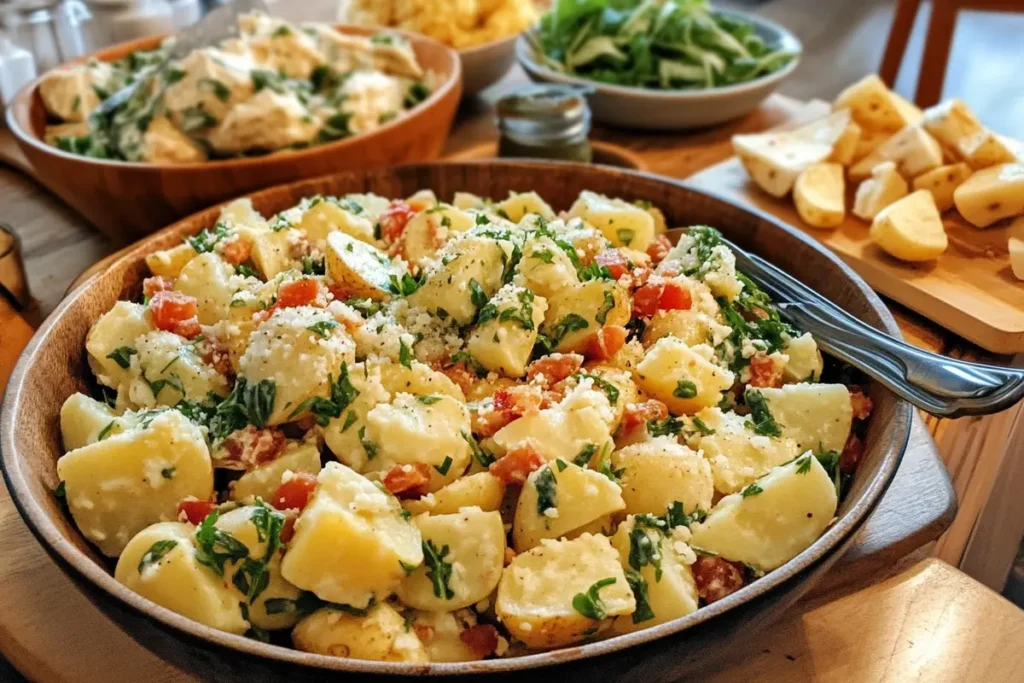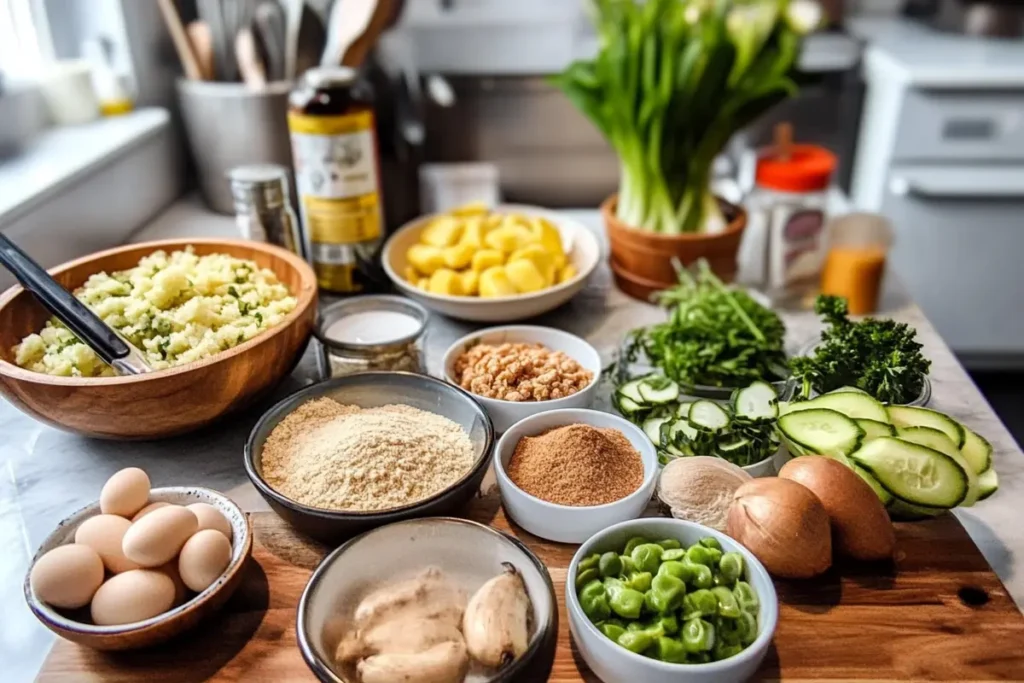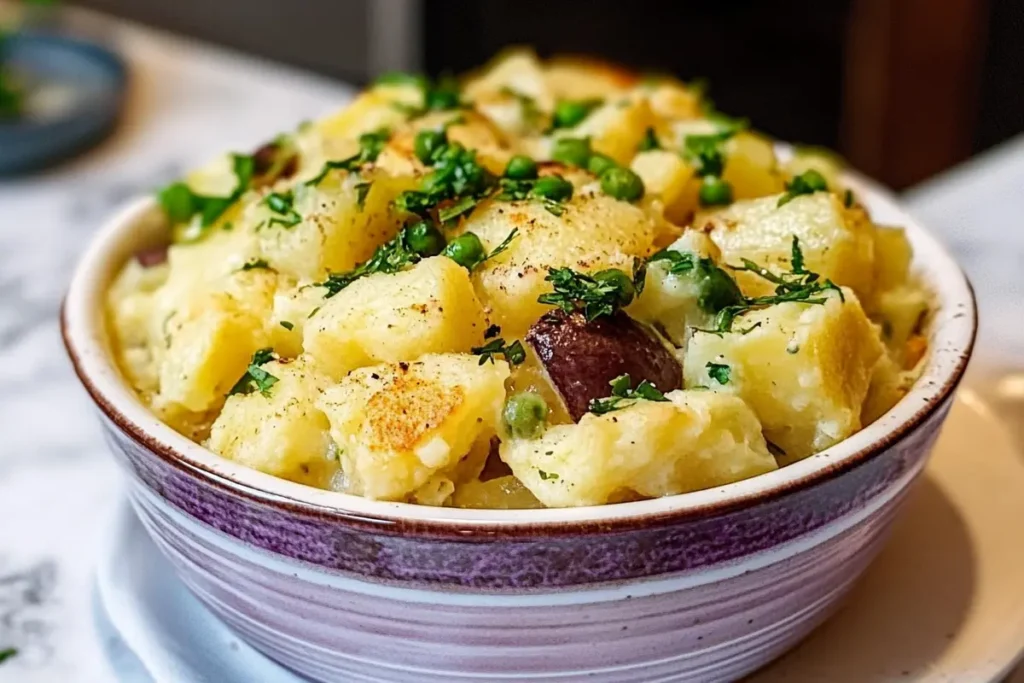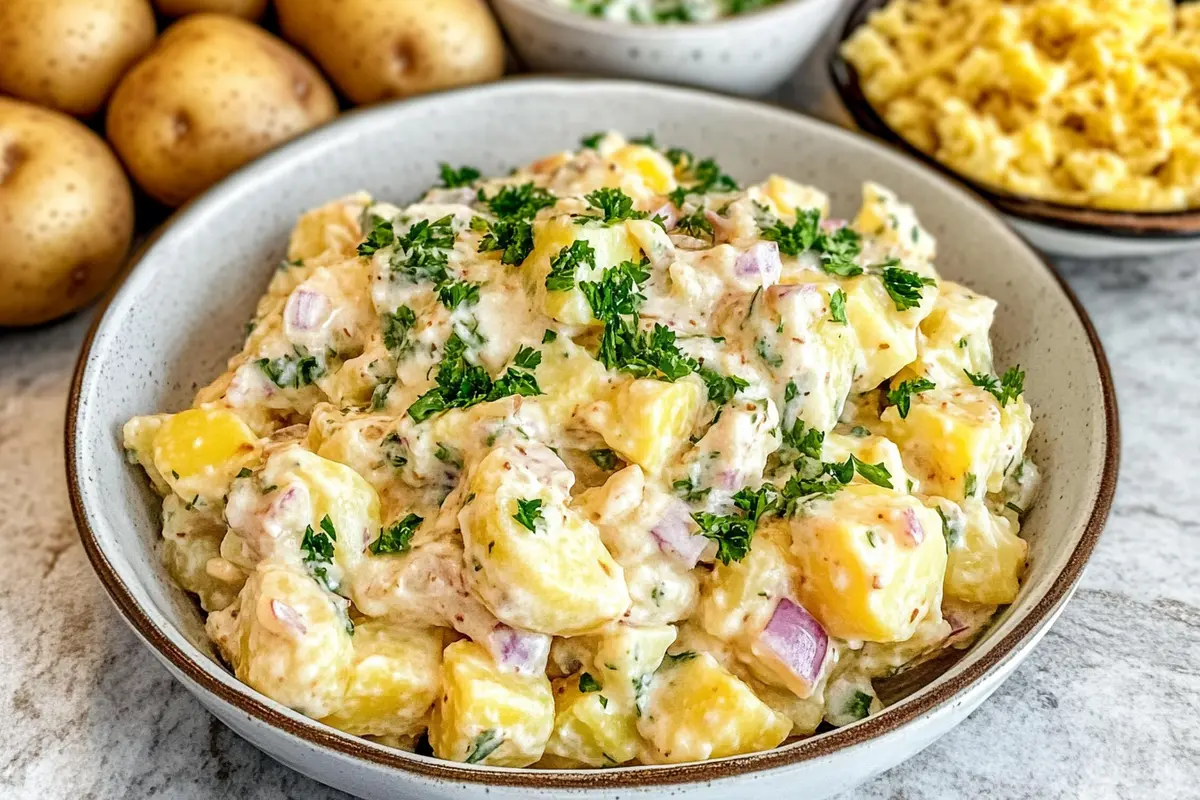Wondering “what not to do when making potato salad?” This article provides key guidance on avoiding common errors. Learn how to make delicious potato salad every time by understanding these important pitfalls, and focusing on best practices.
Understanding Common Potato Salad Mishaps
Making potato salad can be straightforward, yet there are many common mishaps that can impact its taste and texture. This article will explore “what not to do when making potato salad,” highlighting frequent errors and providing useful tips. Specifically, we’ll show you how to achieve satisfying results every time. Indeed, knowing the common mistakes is essential for culinary success.
The Importance of Avoiding Potato Salad Errors
Avoiding frequent errors in potato salad preparation is crucial for the best outcome. Specifically, such errors can lead to a soggy or bland dish, or even create food safety issues. Therefore, understanding and sidestepping these common mistakes is key. Also, a little attention to detail can make all the difference in your final product.
Focusing on Optimal Ingredient Handling
Proper handling of ingredients is a key aspect of preparing delicious potato salad. Specifically, this includes how the potatoes are cooked, how the dressing is prepared, and how everything is mixed. Therefore, focusing on these steps can help you achieve success and the perfect balance of flavors and textures. Indeed, how the ingredients are treated has a significant impact on the final dish.
What Not to Do When Making Potato Salad: Key Errors
There are several things “what not to do when making potato salad” that can hinder a perfect outcome. This section will explain these errors in detail. Specifically, we’ll cover frequent missteps, and explain how you can avoid them, and create a truly delicious side. Indeed, knowledge of these common errors is very important.
Overcooking Potatoes
Overcooking the potatoes is one of the biggest mistakes to avoid in potato salad preparation. Specifically, when potatoes are overcooked, they become mushy, leading to a soggy salad. Furthermore, they lose their shape and texture, which will also impact the taste. Therefore, always cook potatoes until they are just fork-tender. Also, be sure to test them frequently as they cook.
Adding Dressing to Hot Potatoes
Adding the creamy dressing to hot potatoes is another frequent error. Specifically, the heat can cause the mayonnaise to break down and separate. Furthermore, this creates a runny and oily salad and makes the texture very unpleasant. Therefore, always ensure the potatoes are completely cool before you add any dressing. Also, chilling them will also enhance their flavor.
Using the Incorrect Type of Potato
Using the incorrect type of potato can also negatively impact your potato salad. Specifically, starchy potatoes tend to become mushy and absorb excess moisture. Furthermore, this leads to an unpleasant, dense texture. Therefore, you should choose waxy potatoes, like Yukon Gold or red potatoes, for best results. Also, they will hold their shape much better when cooked and mixed.
Adding Too Much Dressing
Adding too much dressing can also create an undesirable balance in your potato salad, leading to a heavy, flavorless dish. Specifically, it can become overly rich and greasy, overpowering the other ingredients. Furthermore, the flavor will be unbalanced. Therefore, you should always start with less dressing and add more as needed. Also, keep in mind that the flavors meld over time.
Skipping the Proper Chilling Step
Skipping the proper chilling step is another common error that can cause the flavors to remain unbalanced. Specifically, chilling the potato salad allows all the flavors to blend and meld together harmoniously. Furthermore, it also helps the salad to set properly and helps prevent sogginess. Therefore, always chill your potato salad for at least two hours. Also, chilling it longer will often create an even better result.
Adding Too Many Ingredients
Adding too many ingredients can also make the salad overly complex and can cause the main flavors to be overwhelmed. Specifically, you should stick to a well-balanced combination of flavors that work together. Furthermore, try not to overdo it and keep it simple. Therefore, you should always avoid adding too many additives and seasonings. Also, make sure to enjoy each ingredient, and choose them thoughtfully.
Handling Techniques to Avoid Common Potato Salad Problems

This section will cover specific handling techniques to avoid common potato salad problems, focusing on best practices for creating a truly delicious dish. Specifically, we’ll discuss how to manage potatoes, dressings, and other ingredients properly, to avoid typical mishaps. Indeed, learning and implementing these techniques will make a big difference in your culinary results.
Cutting Your Potatoes into Uniform Pieces
Cutting your potatoes into uniform pieces helps them to cook evenly, which also prevents some from becoming overcooked, while others are still undercooked. Furthermore, it makes the potato salad easier to eat and also improves the overall presentation of the dish. Therefore, taking the time to cut them to the same size and shape will improve your results. Also, make sure they are not too large or too small.
Preparing Your Dressing Separately
Always prepare your dressing in a separate bowl, to ensure the best result in your potato salad. Specifically, this will allow you to adjust the flavor before adding it to your potatoes, preventing over-seasoning. Furthermore, this will also help you to mix it well before adding it, and you will also be able to taste it as you make it. Therefore, this step allows you better control over the flavor of the dressing. Also, this helps prevent sogginess.
Adding Acidic Ingredients Thoughtfully
When adding acidic ingredients, like vinegar or lemon juice, always do so thoughtfully and gradually. Specifically, you should taste as you add it. Furthermore, doing so helps to prevent the potato salad from becoming too sour, which may alter the entire meal. Therefore, be sure to add acidic ingredients a little at a time and taste it often. Also, use care when using strong flavors.
Stirring Your Potato Salad Gently
When combining all of the ingredients, always stir them gently to protect the potatoes and to keep their shape. Specifically, mix them carefully to avoid making your potatoes mushy. Furthermore, overmixing can change the texture of the salad, so handle it with care. Therefore, use a light hand when stirring. Also, fold the ingredients together, rather than stirring roughly.
Using Fresh and High-Quality Ingredients
Always use fresh, high-quality ingredients when you can, as this can truly impact the taste of your potato salad. Specifically, fresh vegetables, herbs, and seasonings will provide the best possible flavor. Furthermore, they will also add more nutritional value. Therefore, using fresh ingredients greatly enhances the overall flavor of the dish. Also, try and choose the best quality options for a more satisfying meal.
Ingredient Choices and Their Impact on the Potato Salad

The ingredient choices you make can greatly impact the flavor, texture, and overall appeal of this recipe. This section will explore how different ingredients can change the overall quality of your dish. Specifically, we’ll cover potatoes, dressings, and other common additives. Indeed, understanding how they work is a very important part of a good recipe.
The Impact of Different Potato Types on Potato Salad
Different potato types offer drastically different results when making potato salad. Specifically, waxy potatoes hold their shape and texture, while starchy potatoes tend to become fluffy and absorb too much moisture. Furthermore, consider using red or Yukon Gold potatoes for a balanced result. Therefore, making a conscious decision about the type of potato you use is very important. Also, this will make or break the final outcome of your dish.
The Effect of Different Dressings on Potato Salad
The type of dressing you choose can completely change the flavor profile of your potato salad. Specifically, a mayonnaise-based dressing provides a creamy and rich base, and a vinaigrette can provide a tangy contrast. Furthermore, be sure to explore different options to find what you prefer. Therefore, you should choose the dressing that will best enhance your specific style of potato salad. Also, consider using Greek yogurt as a lighter alternative.
The Role of Sweet Additives
Sweet additives, like sweet relish, are often added to potato salad to enhance its flavor. Specifically, these ingredients provide a layer of sweetness that works very well with the savory ingredients. Furthermore, they also add a bit of texture and freshness, which will take your dish to the next level. Therefore, be sure to use them sparingly and to always taste as you go. Also, remember that less is often more when adding sweet touches.
Seasoning and Herbs
Seasoning and herbs are very important for adding complexity to the flavor profile of your potato salad. Specifically, fresh herbs like dill, parsley, and chives are a great addition, providing a refreshing element to the dish. Furthermore, they add a vibrant taste that will enhance your experience. Therefore, carefully consider your seasoning choices. Also, you can experiment with different herbs and flavors.
How Textural Enhancements Impact Potato Salad
Adding textural enhancements, like celery, or cucumber, or even bell peppers, will greatly improve the final outcome of your potato salad. Specifically, these will all provide a satisfying crunch to the dish, contrasting the creamy potatoes. Furthermore, they also provide additional flavor and nutrients to the salad. Therefore, try using a variety of textural enhancements, and be sure to prepare them correctly. Also, using crisp vegetables will add a great crunch.
Variations in Potato Salad: Adjusting Ingredients for Different Needs

While a classic potato salad is a wonderful dish, there are many variations that you can try. This section explores some variations and the ideal times to adjust your ingredients. Specifically, we’ll discuss different diets, preferences, and seasonal options. Indeed, this allows you to create a potato salad that fits a variety of different needs.
Creating Lighter Potato Salad Variations
To make a lighter potato salad variation, consider using ingredients like Greek yogurt or light mayonnaise instead of the classic, full-fat mayonnaise. Furthermore, these alternatives can help you to lower the calories of the dish, and create a lighter option. Therefore, it can be a good option for those limiting calories. Also, try to add more vegetables for some additional nutrients.
Creating a Spicy Potato Salad Variation
For a spicy potato salad variation, you can add a dash of hot sauce or a pinch of red pepper flakes for some extra heat. Furthermore, consider adding some pickled jalapenos for even more spice and flavor. Therefore, try these options if you like a little kick. Also, adjust the heat to suit your personal preferences and tastes.
Creating a Seasonal Potato Salad Variation
When making a seasonal potato salad variation, consider using seasonal ingredients, which will also add a unique touch. Specifically, try using fresh herbs and vegetables that are in season, to make the meal more vibrant. Furthermore, this will ensure that you are using the best quality ingredients. Therefore, this will also create a more fresh dish. Also, try different seasonal options.
Creating a Vegetarian Potato Salad Variation
To create a vegetarian potato salad variation, you can simply skip any meat proteins. Furthermore, be sure to use plant-based mayonnaise. Therefore, it is easy to adapt this recipe to fit vegetarian requirements. Also, you can add extra vegetables to make it even more satisfying.
Making Choices Based on Your Personal Preferences
Adjust your potato salad based on your own personal preferences and the needs of your specific situation. Specifically, you can add or remove any ingredients that you do or do not like, allowing you to tailor the recipe to your needs. Furthermore, this will allow you to create the most harmonious blend of flavors for your palate. Therefore, never be afraid to get creative and experiment. Indeed, this is your chance to explore new things.
Serving and Storing Potato Salad for Optimal Quality
Proper serving and storing of your potato salad are very important for maintaining its quality and freshness. This section provides a few tips on this. Specifically, we’ll cover how to keep it safe and appealing until it’s time to enjoy it. Indeed, both safety and good presentation are very important aspects of any good meal.
Always Serving Your Potato Salad Cold
Always serve your potato salad cold, to ensure that it maintains its quality and is also safe to eat. Specifically, chilling it for at least two hours will help the flavors to meld together and will also keep it at a safe temperature. Furthermore, warm potato salad will not be as satisfying, and it is more likely to spoil. Therefore, keep it in the refrigerator until you are ready to serve. Also, make sure that it does not sit out at room temperature for too long.
Using an Appealing Bowl or Platter
When serving, pay attention to the presentation of your potato salad, as this always enhances the eating experience. Use a clean and appealing bowl or serving platter, that will properly show the salad. Furthermore, you can garnish it with a sprinkle of paprika or some fresh herbs, for a nice visual effect. Therefore, proper presentation makes a big difference and shows attention to detail. Also, always be sure to use a serving spoon to prevent contamination.
Storing Your Potato Salad Properly
Always store any leftover potato salad in an airtight container in the refrigerator. Furthermore, this helps maintain its freshness and prevents spoilage. Therefore, always ensure that it is properly sealed and stored at the right temperature. Also, be sure to label the container with a date.
The Ideal Length for Safe Storage
Ideally, you should consume your potato salad within three to five days, to ensure that it remains safe to eat. Furthermore, it’s not advisable to eat it after this point. Therefore, always exercise caution when storing and eating any leftovers, but especially mayonnaise-based salads. Also, if you are ever in doubt, it is best to discard it.
Understanding Why Knowing “What Not To Do” Is So Essential
Understanding “what not to do when making potato salad” is just as important as knowing all the proper steps for a recipe. This section will explore why avoiding common mistakes matters so much. Specifically, we’ll cover the impact on flavor, texture, and food safety. Indeed, preventing common errors will greatly improve your cooking skills.
You Will Improve Flavor
By avoiding common mistakes, such as over-seasoning or using too much dressing, you’ll create a more balanced and enjoyable flavor profile in your potato salad. Specifically, you will learn the proper amounts of each ingredient and also learn to balance the different flavor profiles. Furthermore, you’ll be able to adjust the ingredients to your own preferences over time. Therefore, you’ll be able to make a much more delicious dish. Also, you’ll develop a better sense of culinary techniques.
Achieving Ideal Texture
By learning and implementing proper cooking techniques for the potatoes, and using good mixing methods, you will be able to achieve a much more satisfying texture. Specifically, you will learn to avoid making the potatoes mushy or making the salad runny. Furthermore, you can also make your own adjustments based on how you like the texture of your potato salad. Therefore, this will make your dish more appealing to the palate. Also, texture is just as important as taste when cooking.
Maintaining Safe Food Practices
Following safe handling and storage practices prevents food safety concerns, and helps you create a safe meal for you and your loved ones. Specifically, you will understand the importance of keeping the salad at a safe temperature. Furthermore, you will also be able to prioritize safe food practices in your cooking routine. Therefore, it’s essential to learn the proper handling and storage methods for the dish. Also, remember that food safety is of the utmost importance.
Enhancing Your Overall Culinary Skills
Learning “what not to do” will enhance your overall culinary skills and will make you a more confident and knowledgeable cook. Specifically, you will learn to be more conscious of your techniques and will be able to identify common errors in the kitchen. Furthermore, you will also learn to troubleshoot problems if they arise. Therefore, this will help you grow as a cook. Also, you will be able to apply what you learn to other recipes, as well.
Creating a Truly Satisfying Dish
Ultimately, avoiding the errors discussed in this article will help you create a more satisfying and enjoyable potato salad. Specifically, your food will be more appealing, more flavorful, and you’ll have a much better and more positive experience making it. Furthermore, it will be a dish that is worthy of praise and of sharing with others. Therefore, understanding the process and how to avoid mistakes will enhance the end result. Indeed, you’ll create a meal that is both fun to make and delicious to eat.
Frequently Asked Questions (FAQs)
What not to do when making potato salad with mayonnaise?
When making potato salad with mayonnaise, avoid adding the dressing to hot potatoes, and never add too much dressing. Furthermore, make sure to always chill the salad thoroughly. Therefore, these tips will prevent many common issues.
Should you rinse potatoes in cold water after boiling for potato salad?
No, you should not rinse your potatoes in cold water after boiling them for potato salad. Specifically, this can cause them to become waterlogged and soggy. Therefore, you should always drain them properly and allow them to cool naturally.
What goes bad in potato salad?
this recipe can go bad due to bacteria growth. Specifically, the mayonnaise is often the ingredient that will cause the most concern. Furthermore, eggs, or other dairy-based ingredients also pose a risk. Therefore, be sure to store it properly and eat it within a few days.
How do you not overcook potatoes for potato salad?
To not overcook potatoes for potato salad, you must test them frequently with a fork while they are cooking and remove them from the heat as soon as they are fork-tender. Furthermore, remember that they will continue to cook slightly even after they are removed from the heat. Therefore, always be careful when cooking them.

